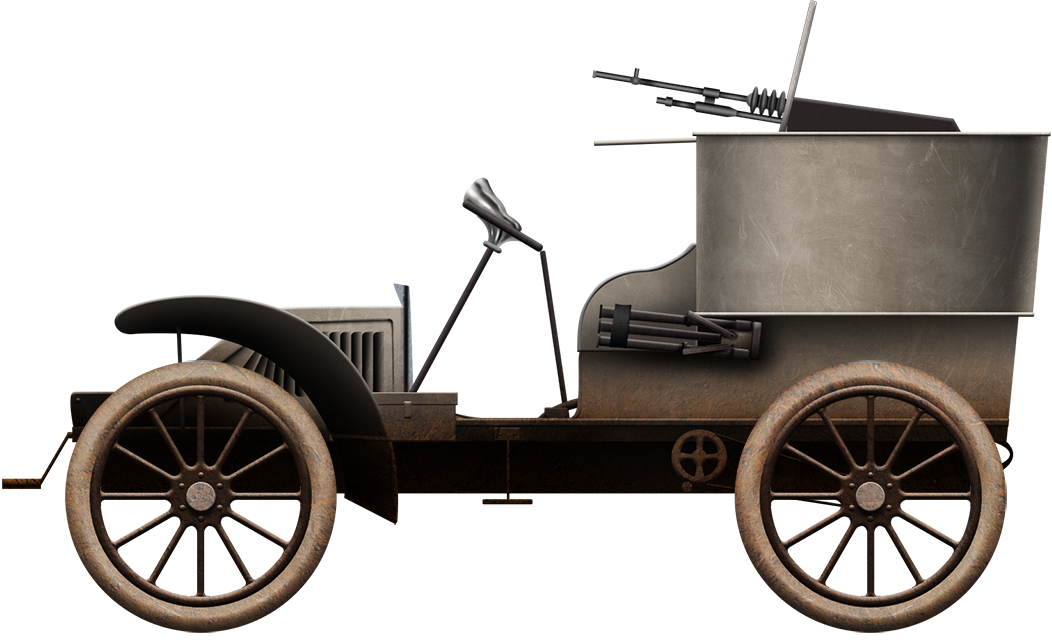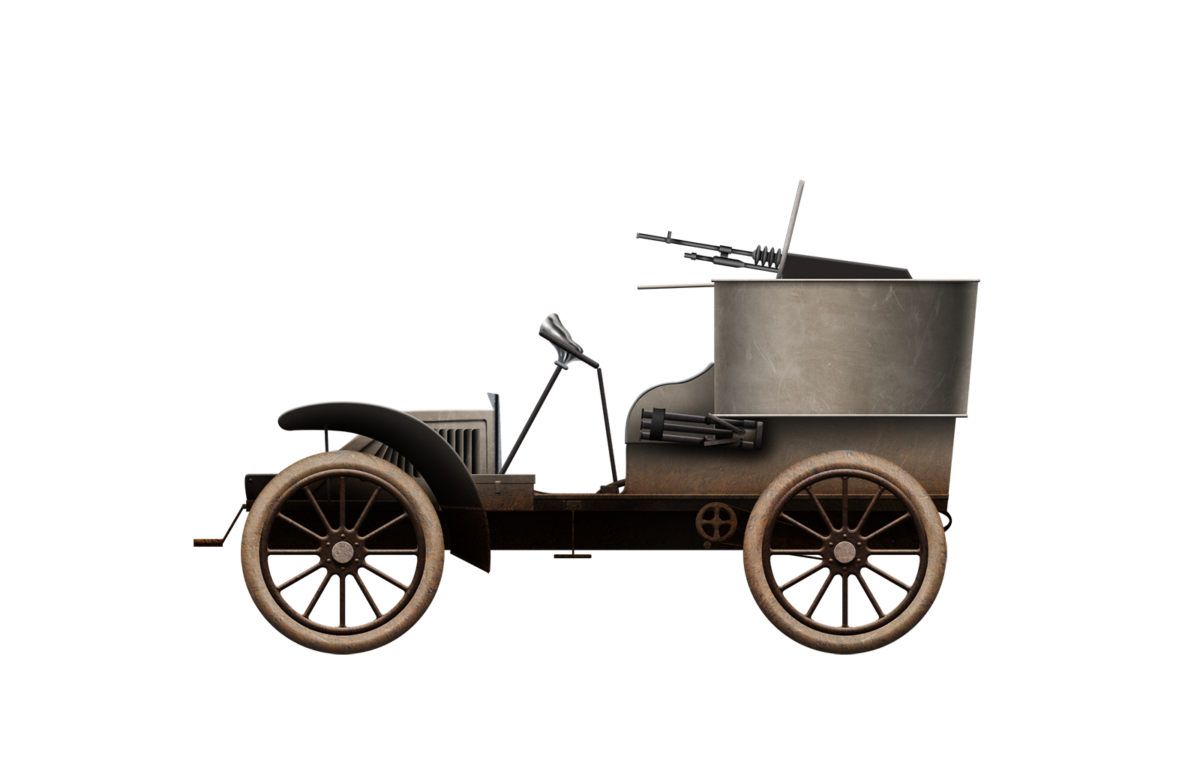 France (1902-1903)
France (1902-1903)
Armored Car – 1 Built
Although the idea of self-propelled armored vehicles existed for quite some time before, the year 1902 brought forth the first vehicles that can, in hindsight, be described as the first armored cars that were actually built. First off appeared the War Car, designed by F.R. Simms in Britain. The other development during this year went on in France by the firm of Charron Girardot Voigt (CGV) and they were able to present their vehicle at the very end of 1902 in Paris. Only the rear portion of the vehicle was armored, leaving the driver and passenger next to him unprotected.

Debut
CGV was founded in 1901 by motorists Fernand Charron, Léonce Girardot, and Émile Voigt. The factory was based in Puteaux, a western suburb of Paris. Several major industries at the time were located in Puteaux, including the factory of Dion-Bouton. After its foundation, CGV started to produce a variety of chassis and engines which were shown at the Salon de l’Automobile et du Cycle (Eng. Car and Bike Show) in Paris at the end of 1902. Eleven (or fifteen, differs between sources) of their models were put on display with engines ranging from 15 to 20 or even 40 hp and differing bodywork. The 40 hp engine was one of two main attractions, as it was a non-dead-center 8-cylinder engine without a governor but, most importantly, the cylinders were made out of gun steel and drilled out, contrary to being cast, as was far more common. The other main attraction was the armored car.
Although the press did not give too much attention to the vehicle, most reports were in favor of the vehicle, but given the show was meant to highlight and present civil cars and engines, the audience was not focussed on new military achievements.

Design
The design of the armored car was quite simple. It was basically a regular 15 hp four-seater passenger car of which the two rear seats were replaced by a circular armored construction in a bath-tub-like shape. In the middle of this thinly armored encirclement, a pedestal was placed on which the machine gun was mounted. A gun shield provided a bit of protection for the gunner. The driver and passenger sat unprotected in front of the armored tub and were thus very vulnerable to hostile fire from the sides and front. A hinged armored plate could be folded upwards above the front seats, but, ironically, only provided protection from their own machine gun and not from enemy fire. The engine produced 15 horsepower, contrary to claims by E. Bartholomew in his book ‘Early armored cars’ (1988), in which he mentioned the vehicle was powered by a 40 hp engine, or by Alain Gougaud in his book ‘L’Aube de la gloire’ (1987) in which he mentioned it to have a 50 hp engine.
The machine gun was developed by the firm Hotchkiss and based on a design made by an officer from Vienna in 1893. The mle. 1897 was exported in 1898 to several countries. This model was further improved, resulting in the mle. 1900. It could fire 600 rounds per minute and was designed to accept 8 mm Lebel rounds. Within the vehicle, 2,470 rounds of ammunition could be taken. At the time the CGV was tested, the French Army was trialing this machine gun as well. The use of this new equipment on the CGV, as well as the presence of a Hotchkiss engineer during the military trials, makes it clear that the armored car was developed in conjunction with Hotchkiss. A tripod for the machine gun was carried on the left side of the vehicle, suggesting the machine gun was to be used in a dismounted position as well.
It is likely that the CGV was inspired by the War Car of Simms, because photographs, reports, and descriptions of this vehicle appeared in abundance in contemporary magazines, journals, and newspapers. However, there is no definite proof of this. In terms of armor and armament, the vehicles do share similarities in the sense that they both feature their armament placed on a pedestal and provided with a gunshield while they stick out of an open-topped rounded armored structure.

Military Trials
After the presentation to the public at the show, the armored car was sent to the French Army. The first military trials took place at Camp de Chalons on June 30 and July 1, 1903. The vehicle was observed by a commission of several officers, including the Commander of the Artillery of the 12th Infantry Division, the UZAC Squadron commander, the Commander of the Artillery of the 5th Cavalry Division, Commander Paloque of the Testing Board from Versailles, and Colonel Rouquerol. The firm Hotchkiss was represented by engineer M. Heryngfet, who also served as a reserve Lieutenant of the 33rd Artillery Regiment.
Already before the trial commenced, the firm of Hotchkiss noted that they were to present a quite different vehicle in the future, jointly with CGV, and that the model should be trialed only superficially as an experimental vehicle. Or, said differently, the idea and the core concept of an armored vehicle were to be tested on a tactical level, as the technical side would be greatly improved with a new vehicle in the near future.

The commission was impressed by the accuracy on the move, which turned out to be roughly 50 percent. They also concluded that the vehicle was powerful enough, as well as maneuverable enough to be able to drive over rough ground and small obstacles if driven by a skilled driver. However, they also saw the weight of the vehicle of 3 tonnes as a drawback, as well as the high price of 45.000 Francs (~223.000 USD in 2015 value). Furthermore, they thought that the vehicle would be exposed to risks that were out of proportion to its power. The number of situations the vehicle would be useful in was thought to be too limited.
The Commission also saw no need in using the armored car as a fighting machine, as that role could also be fulfilled by an unarmored car with a machine gun if it were to accompany a cavalry unit. This idea was further worked out by Captain Genty during the following years. Instead, the Commission saw an armored car to be more suitable for the general staff, to allow officers to move quickly and protected, which would make it ideal for reconnaissance missions and protect against enemy cavalry charges. This idea was actually made a reality with the Opel Kriegswagen, although that was only tested by the German Army.

Further Development
As they had stated before the tests, Hotchkiss and CGV had been working on a better design. Despite the negative conclusion regarding a potential acquisition, this development was not halted. By 1904, Naval Major (R) Paul Alexis Guye joined the project, and the final design would lead to the fully armored CGV model 1906 that also featured a fully enclosed turret armed with a machine gun.
The original design was not discarded either and, in 1909, Hotchkiss managed to secure a deal with Turkey to deliver four armored vehicles known as the Hotchkiss model 1908 or 1909, the design of which was very similar in appearance to the 1902 model. Furthermore, apparently, both the 1902 and 1908 models were studied by the Spanish Army when they wanted to acquire armored vehicles but they opted for another French design, the Schneider-Brillié.

Conclusion
The CGV 1902 marked the beginning of armored vehicle history in France. Initial development went slowly and was basically confined to the firms of CGV (Charron since 1906) and Hotchkiss, although Schneider-Brillié delivered two armored to Spain in 1910. Only World War I would start a sudden, but great increase in the manufacture of armored vehicles in France. The CGV 1902 helped the army to formulate for the first time their thoughts about armored cars and it would provide a lot of experience to the firms of Hotchkiss and CGV, which helped them develop their next vehicles. Besides these significant influences, the vehicle played a minor role in foreign development. That role was reserved for its successor, the CGV model 1906.

This article has been sponsored by Slickdeals.net, a website that offers deals, coupons, promo codes, and discounts. Click on the link to get deals for Ebay merchandise! So, if you want to buy a new tank game (or a PS5!), books or model kits, be sure to check the offers from Slickdeals!
Specifications |
|
| Crew | 3 (driver, gunner, passenger) |
| Weight | 3,000 kg (6,600 lbs) |
| Engine | 11.2 kW (15 hp) |
| Armament | 1x mle. 1900 Hotchkiss 8 mm machine gun |
| Ammunition storage | 2,470 rounds |
| Total Production | 1 |
Sources
L’Aube de la gloire : les autos mitrailleuses et les chars français pendant la grande guerre, Alain Gougaud, 1987.
Tanks 100 years of Evolution, Richard Ogorkiewicz, Osprey Publishing.
Early Armoured Cars, E. Bartholomew, 1988. [used to disprove claims]
“A travers les Stands.” L’Auto-Vélo, December 22, 1902.
“Der Pariser Automobil-Salon 1903.” Neue Freie Presse, December 23, 1902.
FR Patent FR317990A filed 22 January 1902, published 3 November 1902.


6 replies on “Charron Girardot Voigt Model 1902”
It may be mentioned that the rifle may have apparently been disassembled and placed on a tripod that was carried.
https://drive.google.com/file/d/1uqa3CsdNgjTYy_rc4yb2TZmN7CcO-WKn/view?usp=sharing
Thanks for your remark Jan, you’re right. The same feature was carried over to the Hotchkiss 1908/1909 model. I’ll add it to the article.
Kind regards, Leander (author)
Wouldn’t the gun hit the driver on the back of the head if it was firing forwards?
Just think of anything bad that would happen with this terrible, terrible design, and chances are you’re probably corrct in assuming so
This “Armoured Car” makes my soul hurt.
What could the speed be.